Base idle speed adjustment
Note. The rated idle speed is set at the factory with the idle speed screw (SAS) and usually does not require additional adjustment during operation.
If by mistake the factory setting was violated, then a significant increase in the idling speed may occur or its drop when an additional load on the engine is turned on (e.g. air conditioner compressor). If this occurs, the adjustment is made as described below.
Before adjusting, check that the spark plugs, injectors, idle speed control (ISC) are serviceable, and that the compression in the cylinders lies in the range from the nominal to the maximum allowable value, and that the difference in compression between the cylinders does not exceed the maximum allowable value.
Before checking and adjusting, prepare the car for testing (warm up the engine to normal coolant temperature).
Connect MUT-II to diagnostic socket (16 pin).
Note. When connecting MUT-II, connect with «weight» diagnostic output.
Start the engine and set the idle speed.
Select item #30 from the menu «Actuator test» (Checking actuators) tester MUT-II.
Note. This keeps the idle speed control servomotor (ISC) at the basic idle speed, which allows you to adjust it.
Check the engine speed at idle.
Rated value: 750±50 min-1.
Note. On a new car (with a mileage of not more than 500 km) idling speed can be less than the nominal by 20-100 minutes-1, but no adjustment is required in this case.
If on a car with a mileage of more than 500 km, the engine stalls or the idle speed is too low, then foreign particles have probably been deposited on the throttle, so it needs to be cleaned.
If the idle speed differs from the nominal, then adjust it by turning the idle speed adjustment screw (SAS).
Note. If the idle speed is higher than the rated speed even when the idle speed screw is fully turned (SAS), then check if the paint on the stop screw of the throttle lever is damaged («Fixed SAS», i.e. Has it been previously adjusted?). If the paint is damaged, adjust the position of the throttle lever stop screw («Fixed SAS»).
Click the button «WITH» (Clear) MUT-II to exit mode «Actuator test» (mode of forced control of executive devices).
Note. If the mode «Actuator test» not cancel, then forced control of actuators (idle speed control servo) will continue for 27 minutes.
Turn the ignition key to position «OFF» («OFF».)
Disconnect MUT-II.
Start the engine and let it idle for about 10 minutes, then check that the engine is idling properly.
Fuel pressure check
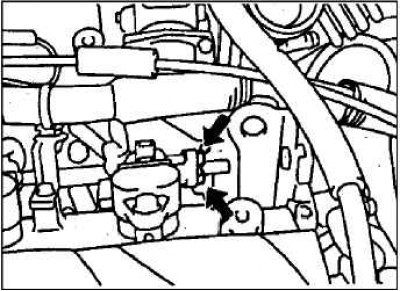
To prevent fuel splashing, bleed residual pressure from the high pressure fuel line.
Disconnect the high pressure fuel hose flange from the fuel manifold.
Attention! Cover the junction of the high pressure hose flange with the fuel manifold with a rag to avoid fuel splashing due to residual pressure in the high pressure line.
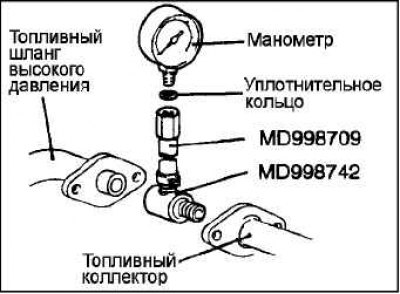
Disconnect the coupling and bypass bolt from the special tool (hose adapter MD 998709) and connect a special tool instead (hose adapter MD 998742). Screw the fuel pressure gauge into the adapter hose assembled earlier. When doing this, be sure to install a suitable sealing ring (gasket) between the pressure gauge fitting and the spec. tool to prevent fuel leaks.
Install the special tool between the fuel manifold and the high pressure fuel hose flange.
With wire connector «crocodile» connect
positive (+) battery terminal with the output of the 2-pin service connector of the fuel pump, as shown in the figure, thereby turning on the latter. Check (when there is pressure in the high pressure line) absence of fuel leaks at the joints of the pressure gauge and special tools.
To stop the fuel pump, disconnect the wire with the connector «crocodile» from the battery.
Start the engine and let it idle.
While the engine is idling, measure the fuel pressure.
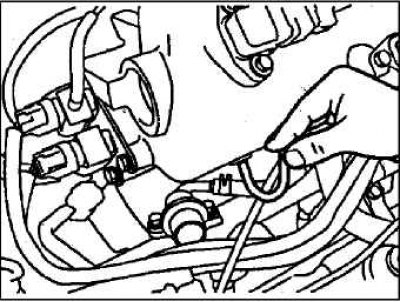
Rated value: Approximately 265 kPa at base idle speed.
Disconnect the vacuum hose from the fuel pressure regulator, cover its opening with your finger and measure the pressure.
Rated value: 324-343 kPa at base idle speed.
Check that the fuel pressure at idle does not drop even after a few presses on the accelerator pedal.
While depressing the accelerator pedal several times in a row, lightly pinch the fuel return hose with your fingers to feel the presence of fuel pressure in the hose.
Note. If the fuel flow is low, no pressure will be felt in the fuel return hose.
Note. If any of the fuel pressure test results are not correct, troubleshoot and correct them according to the table below.
Stop the engine and check for changes in the fuel pressure gauge reading.
The fuel system is serviceable if the pressure in the fuel line does not decrease within 2 minutes. If the pressure drops, then troubleshoot and eliminate it in accordance with the table.
Relieve any residual pressure in the high pressure fuel line.
Disconnect the pressure gauge and spec. fuel manifold tool.
Attention! Cover the connections between the hose flange and adapter with a rag to avoid fuel splashing due to residual fuel pressure in the high pressure line.
Replace the O-ring on the high pressure hose flange with a new one. Before installing, be sure to lubricate the O-ring with clean engine oil.
Install the high pressure fuel hose tube flange into the fuel manifold and tighten the flange mounting bolts to the specified torque.
Tightening torque: 5 Nm
Check for fuel leaks.
To turn on the fuel pump, connect the output of the service connector of the fuel pump to «+» battery terminal.
Check for leaks in the fuel line when the latter is under pressure.
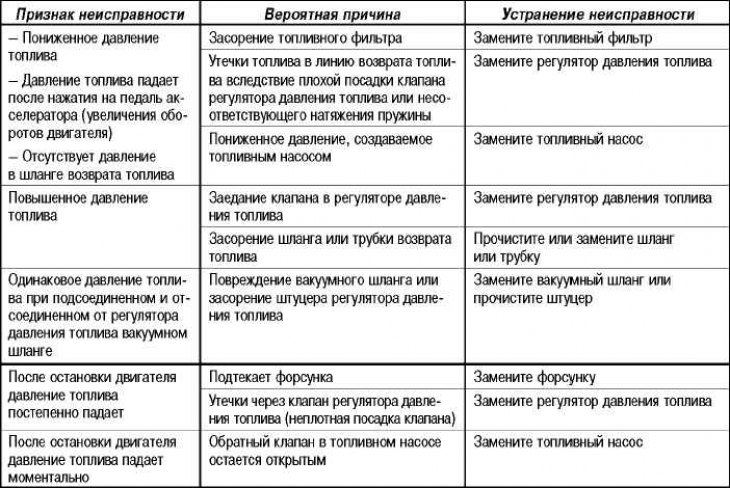
Checking the circuit of the control relay and the fuel pump relay
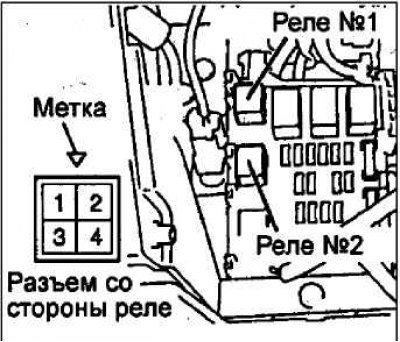

Checking the air temperature sensor in the intake manifold
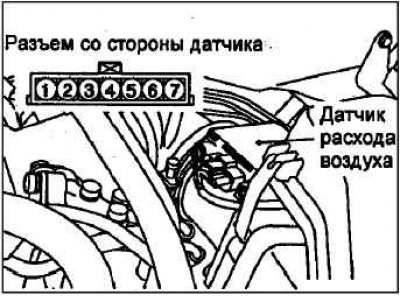
Disconnect the air flow sensor connector.
Measure the resistance between pins 5 and 6.
Rated value: 2.3-3.0 kΩ (at 20°C); 0.30-0.42 kΩ (at 80°C).
Measure the resistance by heating the probe with a hair dryer.
Working condition

If the resistance is out of specification or does not change with temperature, replace the air mass sensor.
Checking the coolant temperature sensor
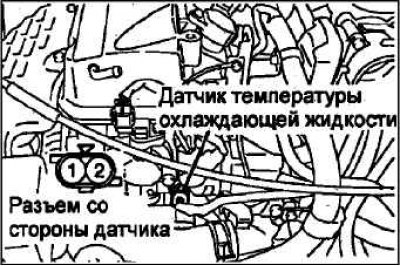
Remove the coolant temperature sensor.
Attention! When removing and installing the sensor, do not touch the tool to its connector (plastic part).
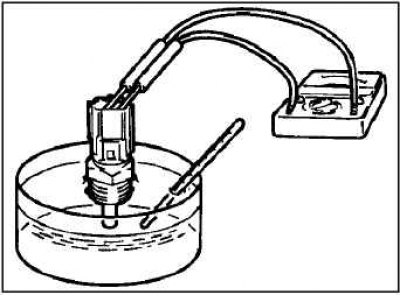
Dip the sensor element in hot water and measure the resistance.
Rated value: 2.1-2.7 kΩ (at 20°C); 0.26-0.36 kΩ (at 80°C).
If the resistance value is significantly different from the nominal value, replace the sensor.

Apply sealant to the sensor threads.
Recommended Sealant: 3M NUT Locking Part #4171 or equivalent
Reinstall the coolant temperature sensor and tighten to the specified torque.
Nominal tightening torque: 30 Nm.
Connect the connector to the sensor.
Throttle position sensor test (TPS)
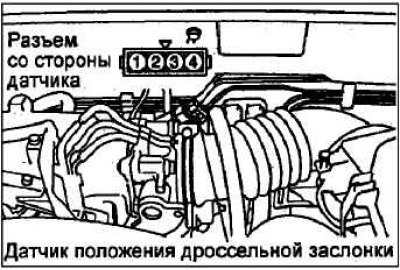
Disconnect the throttle position sensor connector. Measure the resistance between terminals 1 and 4 of the connector on the sensor side.
Rated value 3.5–6.5 kΩ.
Measure the resistance between pin 2 and 4 of the sensor side connector.
Slowly open the throttle from a fully closed (idling) position to fully open. The sensor is OK if the resistance changes smoothly in proportion to the throttle opening angle.
If the resistance is out of specification or does not change smoothly, replace the throttle position sensor.
Checking the sensor-switch of the fully closed position of the throttle valve
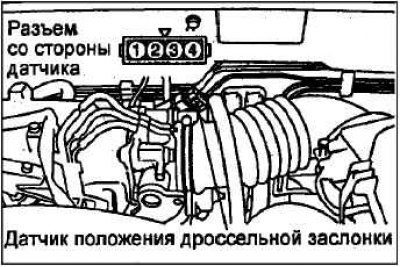
Disconnect the throttle position sensor connector.
Check the circuit between terminals 3 and 4 of the throttle position sensor connector.
Working condition

If the circuits are not as specified above, replace the throttle position sensor.
Note. After replacement, it is necessary to adjust the throttle position sensor and the fully closed throttle position switch.
Checking the front oxygen sensor
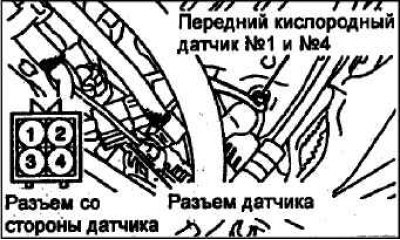
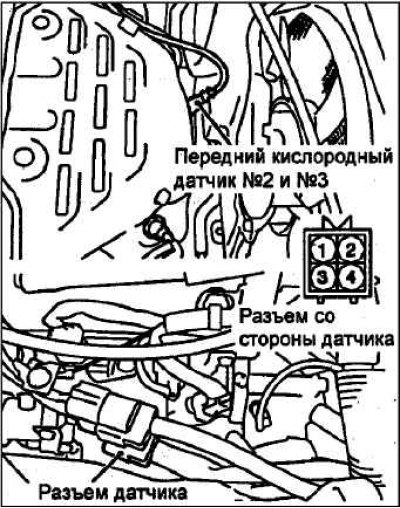
Disconnect the oxygen sensor connector and connect a special tool to the connector on the sensor side (test lead harness).
Check for continuity between pin 3 and pin 4 of the oxygen sensor connector (resistance between terminals is 4.5–8.0 ohms at 20°C).
If the circuit is open, replace the oxygen sensor.
Warm up the engine to a coolant temperature of 80°C or higher.
With wire connectors «crocodile» connect pin 3 of the oxygen sensor connector to «+» battery terminal, and pin 4 - to «–» battery terminal.
Attention! Be very careful when connecting wires with connectors «crocodile» to battery terminals (do not reverse the polarity); incorrect wiring may damage the oxygen sensor.
Connect Digital (electronic) voltmeter to conclusions 1 and 2. Periodically pressing the accelerator pedal, measure the output voltage of the oxygen sensor.
Rated value
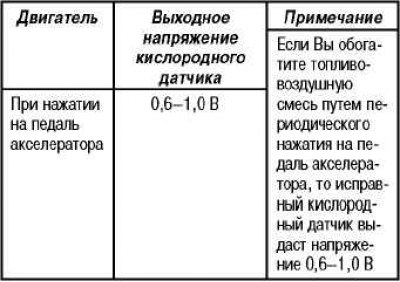
If the oxygen sensor is faulty, replace it.
Checking the rear oxygen sensor
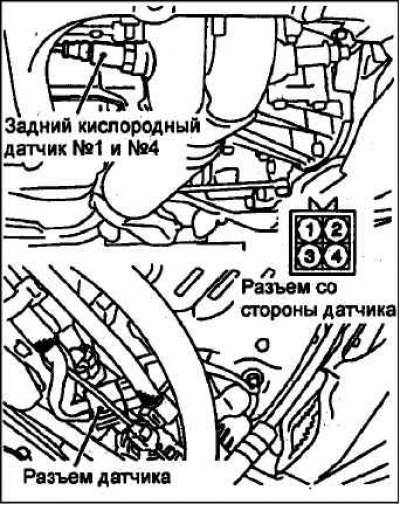
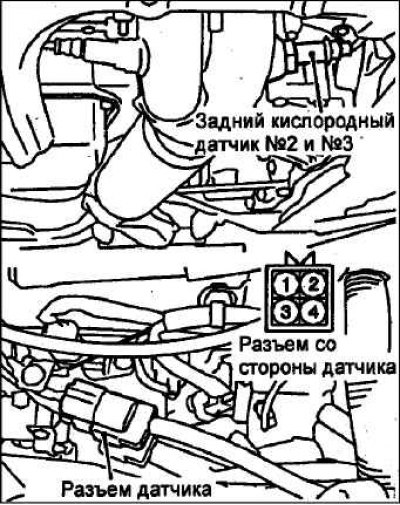
Disconnect the connector of the oxygen sensor and connect a special tool to it from the side of the sensor (test lead harness).
Check that the circuit between terminals 3 and 4 of the oxygen sensor connector is closed (resistance between terminals is 11–18 ohms at 20°C).
If the circuit is open, replace the oxygen sensor.
Note. If the MUT-II does not show nominal values even though the above circuit test found no fault, replace the oxygen sensor (rear).
Change in resistance between injector terminals

Disconnect the connector from the injector.
Measure the resistance between the leads.
Rated value: 13-16 ohms (at 20°C).
Connect the injector connector.
Checking the shape of the nozzle spray pattern and the tightness of the nozzle
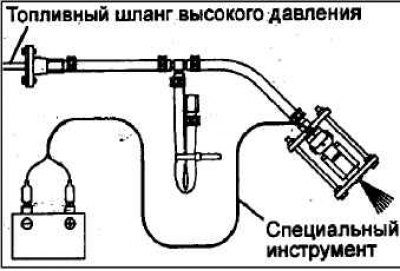
Relieve residual pressure from the fuel line according to the procedure below to prevent fuel splashing.
Remove the nozzle.
Assemble the special tool (injector test kit), adapter, pressure regulator and clamps as shown.
Connect battery voltage to terminal No. 2 of the three-prong fuel pump service connector as shown, and turn on the fuel pump.
Activate the injector and check the quality of fuel atomization from the injector.
The condition of the nozzle is satisfactory if the nozzle gives a normal spray.

Disconnect the wires from the terminals of the injector connectors and check for leaks (atomizer and locking needle) nozzles.
Value: 1 drop or less per minute
Connect the wires from the battery terminals to the injector terminals, not including the fuel pump. Then, after stopping the spray of fuel from the nozzle, disconnect the special. tool, reset the nozzle.
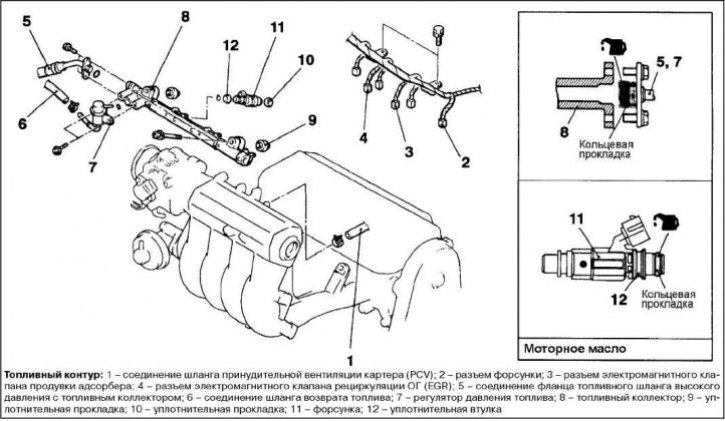
Checking the idle speed control servo (stepper motor; ISC) (checking for the sound of a running stepper motor)

Check that the coolant temperature is 20°C or lower.
Note. It is also possible to disconnect the coolant temperature sensor connector and connect another coolant temperature sensor with a temperature of 20°C to the connector on the wiring harness side. Disconnect and connect the electrical connector with the ignition off).
Check if the sound of a running stepper motor can be heard after the ignition key has been turned to the «ON» («ON»; without starting the engine).
If the sound of a running stepper motor is not audible, then check the circuits of the stator windings of the electric motor.
If no fault is found in the circuits, then there is probably a fault in the idle speed control servo (stepper motor) or in the electronic engine control unit.
Winding resistance test
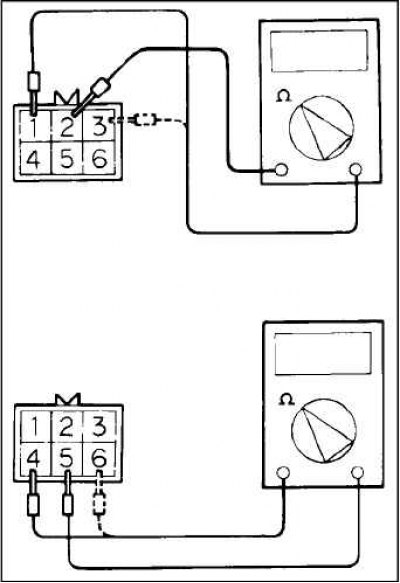
Disconnect the idle speed control connector and connect the special tool (test lead harness).
Measure the resistance between pin 2 (white clip) and output 1 (red clip), and then output 3 (blue clip) on the side of the idle speed control connector.
Rated value: 28-33 ohms (at 20°C).
Measure the resistance between pin 5 (green clamp) and output 6 (yellow clamp), and then output 4 (black clip) idle speed control connector.
Rated value: 28-33 ohms (at 20°C).
